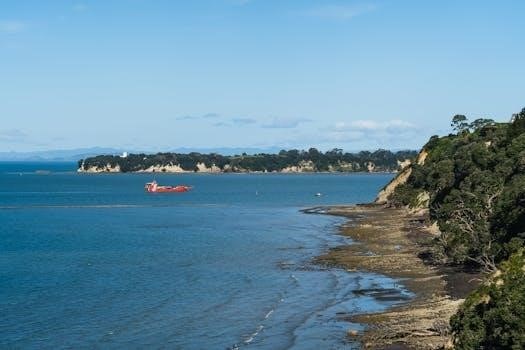Bay of Fires Self-Guided Walks⁚ An Overview
The Bay of Fires, located on Tasmania’s northeastern coast, beckons with its white beaches, azure seas, and orange-lichened rocks. Self-guided walks offer an immersive experience, allowing exploration at your own pace, discovering hidden coves and stunning coastal scenery.
The Bay of Fires, or larapuna, stretches along Tasmania’s northeastern coast, famed for its vibrant orange granite boulders, pristine white beaches, and clear turquoise waters. Named by a British sailor due to Aboriginal campfires sighted along the shore, it offers a stunning landscape for exploration. While the original inhabitants are gone, the physical beauty remains, attracting nature lovers and hikers. Self-guided walks provide an intimate way to experience this awe-inspiring region, offering an escape into a remote and wonderfully scenic environment. Prepare to be captivated by the contrasting colours and untouched beauty of the Bay of Fires.

Planning Your Self-Guided Bay of Fires Walk
Careful planning is key for a successful self-guided walk. Consider remoteness, gravel road access, and necessary gear. Detailed maps, accommodation, and transportation arrangements should be organised to ensure a safe and enjoyable adventure.
Considerations for Remote Coastal Hiking
Embarking on a self-guided walk in the Bay of Fires requires acknowledging its remote coastal environment. Access is often limited to gravel roads and walking tracks. Many car rental companies have restrictions on driving on unsealed roads, so check your rental agreement carefully. Plan for limited phone service and bring navigation tools.
Consider the changeable weather conditions and potential hazards like uneven terrain. Be prepared for self-sufficiency, as assistance may not be readily available. Pack extra food and water. Ensure you inform someone of your hiking plans and estimated return time. Prioritize safety above all else.
Essential Gear and Supplies
Proper gear is paramount for a safe and enjoyable self-guided walk in the Bay of Fires. Sturdy hiking boots are crucial for navigating varied terrain, including beaches and rocky headlands. Pack layers of clothing to adapt to changing weather conditions. A waterproof jacket is essential.
Carry sufficient water and high-energy snacks. A detailed map, compass, or GPS device is vital for navigation. A first-aid kit should include blister treatment, pain relievers, and antiseptic wipes. Don’t forget sunscreen, a hat, and insect repellent. A fully charged phone or power bank is recommended for emergencies.
Popular Self-Guided Walking Trails
The Bay of Fires offers numerous self-guided trails, catering to various fitness levels. From short beach strolls to longer coastal hikes, these trails showcase the area’s natural beauty and diverse landscapes.
Short Walks in Bay of Fires Conservation Area
The Bay of Fires Conservation Area boasts several accessible short walks, ideal for families or those seeking a less strenuous experience. These trails often meander along pristine beaches, offering breathtaking views of the turquoise waters and iconic orange-hued boulders. Perfect for a leisurely exploration, these shorter routes allow you to soak in the beauty of the Bay of Fires without committing to a full-day trek. Keep an eye out for diverse birdlife and native flora along the way. Enjoy hand-curated trail maps for walking and hiking.
Swincart Lagoon Walk
The Swincart Lagoon Walk provides a gentle, scenic alternative to the more challenging coastal trails in the Bay of Fires. This 3.1km track meanders through diverse landscapes, showcasing wildflowers, native plants, and tranquil lagoon views. Ideal for birdwatching and spotting local wildlife, the walk also connects to several beautiful beach spots, offering opportunities for swimming and relaxation. With its ease of access and stunning scenery, the Swincart Lagoon Walk is perfect for families and those seeking a peaceful nature experience. The path has wildflowers, native plants and beach spots.
Logistics and Accessibility
Reaching the Bay of Fires requires planning, considering its remote location. Access is often via gravel roads, and transportation options should align with your itinerary and any car rental agreements concerning unsealed road travel.
Getting to the Bay of Fires
Planning a self-guided walk in the Bay of Fires begins with understanding how to get there. The region is situated along Tasmania’s northeast coast, and while stunning, it’s relatively remote. Most visitors arrive via Launceston, the nearest major city with an airport. From Launceston, you’ll need to drive approximately 2 to 3 hours to reach the Bay of Fires area.
Consider renting a car for flexibility in exploring different trailheads and coastal sections. Be aware that some roads leading to specific areas are gravel, so check your rental car agreement.
Transportation Options and Gravel Road Considerations
While renting a car offers the most freedom for a self-guided Bay of Fires adventure, other transportation options exist. Limited public transport serves the area, so buses may not be a practical choice for accessing trailheads. Private transfers or shuttle services can be arranged from Launceston, but these require advance booking.
Gravel roads are common in the Bay of Fires region, providing access to many coastal spots. Check your rental agreement, as some companies restrict driving on unsealed roads. Drive cautiously and consider a vehicle with higher clearance.

Accommodation Options for Self-Guided Walkers
From camping under the stars to cozy coastal retreats, the Bay of Fires offers diverse lodging. Secure your spot well in advance, especially during peak season, to ensure a comfortable base for exploration.
Staying Near the Bay of Fires
For self-guided walkers seeking accommodation near the Bay of Fires, several options cater to different preferences and budgets. Binalong Bay offers convenient access and a range of houses to rent. Further south, St Helens provides a larger town setting with hotels, motels, and caravan parks. Consider staying in these areas for easy access to trailheads and amenities, which is particularly important if you are planning to explore multiple sections of the Bay of Fires coastline. Booking in advance is highly recommended, especially during peak season, to secure your preferred lodging.

Safety and Responsible Hiking
Prioritize safety on your Bay of Fires self-guided walk. Be aware of potential hazards, like changing weather and slippery rocks. Respect the environment by staying on marked trails and leaving no trace behind, thus protecting this area.
Respecting the Environment and Aboriginal Heritage
The Bay of Fires holds significant cultural importance for Aboriginal Australians. As you explore this stunning landscape, remember to tread lightly and respect the environment. Avoid disturbing any cultural sites, rock formations, or native flora and fauna. Pack out all your trash and minimize your impact on the fragile ecosystem. Stay on designated trails to prevent erosion and protect sensitive areas. Learn about the history and significance of the area to deepen your understanding and appreciation. By respecting the environment and Aboriginal heritage, you contribute to the preservation of this natural treasure for generations to come. Remember, responsible hiking ensures the Bay of Fires remains pristine.
Navigating Trails and Potential Hazards
Navigating the Bay of Fires trails requires awareness and preparation. While some paths are well-defined, others may be less so, especially in remote areas. Carry detailed maps and a compass, or a GPS device, and know how to use them. Be mindful of changing weather conditions, as coastal areas can experience sudden shifts. Watch out for slippery rocks, especially near the shoreline. Be aware of potential hazards like snakes, and take precautions to avoid encounters. Check tide times if your walk involves beach sections. Let someone know your hiking plans and expected return time. With careful planning and attention, you can navigate the trails safely and enjoyably.
Alternatives to Self-Guided Walking
For those seeking a different experience, guided walking tours offer expert insights and logistical support. The Bay of Fires Signature Walk provides a luxurious, immersive option, showcasing the region’s beauty with comfortable accommodations and curated itineraries.
Guided Walking Tours
Opting for a guided walking tour in the Bay of Fires offers several advantages. These tours, often led by experienced guides, provide valuable insights into the region’s history, ecology, and Aboriginal heritage. Furthermore, logistics such as transportation, accommodation, and meals are typically handled by the tour operator, allowing you to fully immerse yourself in the natural beauty. Some tours even include unique experiences like wilderness cruises to explore the coastline from the water. These tours cater to various fitness levels and interests, offering a tailored experience in this stunning Tasmanian landscape.
Bay of Fires Signature Walk
The Bay of Fires Signature Walk presents an immersive, multi-day experience along Tasmania’s stunning east coast. This guided walk caters to those seeking a blend of luxury and adventure, often featuring comfortable accommodations and gourmet meals. Expert guides lead small groups through remote landscapes, sharing insights into the area’s natural and cultural significance. The Signature Walk typically includes highlights such as exploring pristine beaches, traversing rocky headlands, and kayaking in crystal-clear waters. This all-inclusive experience allows participants to fully appreciate the beauty of the Bay of Fires without the logistical concerns of self-guided trekking.

Enhancing Your Bay of Fires Experience
Beyond the trails, enrich your Bay of Fires journey by embracing wildlife viewing. Capture the scenery with photography, highlighting the vibrant colours and breathtaking coastal views, creating lasting memories of your adventure.
Wildlife Viewing Opportunities
The Bay of Fires is not just about stunning landscapes; it’s also a haven for diverse wildlife. Keep an eye out for native birds soaring above, such as sea eagles and various coastal birds. The coastal waters are home to marine life, including dolphins and seals, so bring binoculars for potential sightings.
Exploring the intertidal zones during low tide can reveal fascinating creatures like crabs and starfish. Remember to observe wildlife respectfully, maintaining a safe distance and avoiding disturbance to their natural habitat. This contributes to preserving the Bay of Fires’ unique ecosystem.
Photography Tips for Capturing the Scenery
The Bay of Fires offers incredible photographic opportunities. Capture the vibrant contrast of orange rocks, white sands, and turquoise waters, utilizing the golden hours of sunrise and sunset for the best light. A wide-angle lens is ideal for expansive landscapes, while a telephoto lens can isolate distant details.
Experiment with composition, using leading lines and the rule of thirds to create visually appealing images. Protect your equipment from the elements, particularly sand and sea spray. Consider using a polarizing filter to reduce glare and enhance colors; Finally, remember to respect the environment while capturing its beauty.
